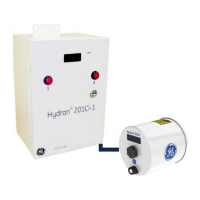14.5 Historic Data Verification
Frequency: Annually or on alarm
In addition to the annual or on-alarm verification, the Hydran 201Ti’s historic data
must also be read regularly by the user.
If the data is read from the H201Ti, follow the instructions in Section 5.5.1. The data
can be collected using a host computer running the Hydran Host software (see the
Hydran Host Software Manual).
The historic data are verified as follows:
1. Consult the historic data file Events to investigate suspicious alarms and other
events.
2. Consult the historic data files Short Term and Long Term to study the evolution of
the gas level and the hourly and daily trends.
3. Ensure the hourly and daily trends periods are optimized. Change the values if
necessary.
4. Examine every alarm setting. Change the values if necessary.
Note: Alarm settings should be modified by authorized personnel only.
14.6 Dissolved Gas Analysis (DGA)
Frequency: Annually (minimum) or on alarm
The dissolved gas analysis (DGA) is the reference method used to determine the exact
level of dissolved gases in oil. A DGA should be performed at least once a year.
To verify the readings of the Hydran 201i System using a DGA, proceed as follows:
1. Note the Hydran 201Ti’s gas level reading.
2. Take an oil sample from the Hydran 201 sensor’s sampling port (see Appendix I).
3. Send the sample to a qualified laboratory.
The DGA results include the concentrations, in parts per million (ppm), of the following
gases:
• Hydrogen (H
2
)
• Carbon monoxide (CO)
• Acetylene (C
2
H
2
)
• Ethylene (C
2
H
4
)
• Methane (CH
4
)
• Ethane (C
2
H
6
)
• Carbon dioxide (CO
2
)
• Nitrogen (N
2
)
• Oxygen (O
2
)

